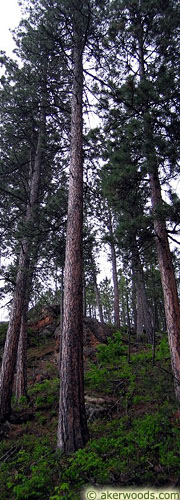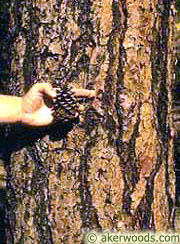Aker Woods: Tree Species (Ponderosa Pine)
 Ponderosa Pines have sharp, dark green needles and thick bark. As the trees mature, the bark changes from black-brown to a yellow-orange color, and covers the tree in large plates with deep furrows between the plates of bark. The difference in bark is so striking that many people mistake young Ponderosas and mature Ponderosas for different species. One of the most attractive characteristics of Ponderosas is their tendency to self-prune. As the tree matures, lower branches die and fall off, which accentuates the unique bark pattern and color. Your sense of smell is also needed to fully appreciate a Ponderosa forest. On hot, calm days in the spring, the air is filled with a pine scent. In the Black Hills, the growth limit for Ponderosas is about 80' in height and 24" in diameter. There are Ponderosas in the Black Hills which are several hundred years old, but they're rare. Most large trees are no more than 150 years old. Ponderosa Pines have sharp, dark green needles and thick bark. As the trees mature, the bark changes from black-brown to a yellow-orange color, and covers the tree in large plates with deep furrows between the plates of bark. The difference in bark is so striking that many people mistake young Ponderosas and mature Ponderosas for different species. One of the most attractive characteristics of Ponderosas is their tendency to self-prune. As the tree matures, lower branches die and fall off, which accentuates the unique bark pattern and color. Your sense of smell is also needed to fully appreciate a Ponderosa forest. On hot, calm days in the spring, the air is filled with a pine scent. In the Black Hills, the growth limit for Ponderosas is about 80' in height and 24" in diameter. There are Ponderosas in the Black Hills which are several hundred years old, but they're rare. Most large trees are no more than 150 years old.
The Black Hills has one of the purest stands of Ponderosa Pine in the world. Rainfall, temperatures, and soils make it an ideal place for Ponderosas to sprout and take root. Other timber species, like Bur Oak, Black Hills Spruce, Quaking Aspen and Paper Birch, find it difficult to compete with Ponderosas in most of the forest. Only in canyons, recent burn areas, and the highest, wettest parts of the Black Hills will you find these other species.
Ponderosas sprout so abundantly in the Black Hills, there is no need to replant after logging. The reverse is true. The trees sprout so close together, it's usually necessary to thin them when they're saplings to get good timber growth. Ponderosas are usually selectively harvested rather than clear-cut. This method of logging removes only defective, declining, and crowded trees, leaving the best trees behind to re-seed and continue growing. Selective harvesting often makes it difficult to identify a recently-logged stand. On a site with good moisture and soils, Ponderosas can be harvested every 30 years. Many areas of the Black Hills have been harvested 4 times since creation of the Black Hills National Forest, the nation's first. Because Ponderosas have such dominance in the Black Hills, the forest service and some private landowners clear small areas of Ponderosas to promote the growth of other species and to preserve meadows.
 Ponderosa Pine (pinus ponderosa) is one of the Western pine species that includes Idaho White Pine (pinus monticola), Sugar Pine (pinus lambertiana) and Lodgepole Pine (pinus contorta). The Western pines are distinct from the Southern Yellow pines, which are denser and pitchier, with widely different characteristics and uses. Ponderosa Pine (pinus ponderosa) is one of the Western pine species that includes Idaho White Pine (pinus monticola), Sugar Pine (pinus lambertiana) and Lodgepole Pine (pinus contorta). The Western pines are distinct from the Southern Yellow pines, which are denser and pitchier, with widely different characteristics and uses.
All Ponderosa Pine is dried before planing to assure uniformity of the finished size. It is dry-kilned or stacked and air-dried until the moisture content reaches the desired level--from 12 to 19 percent.
Ponderosa can be subject to "blueing". If a felled tree is subjected to high humidity and temperature, occasional light blue streaks will appear in the lumber. Blueing does not affect strength or durability and blued lumber is often prized for the visual interest it adds to the wood.
Ponderosa Pine has a rose-toned heartwood and a wide, cream-colored sapwood. It has a straight, uniform grain which machines to a smooth surface with very distinct growth rings.
All woods shrink and swell as their moisture content fluctuates with the relative humidity. But after drying, Ponderosa is relatively unaffected by changes in humidity, making it valuable for uses which require tight joints. It's also less prone to split, cup, or twist than most other species. Its lack of resin pockets and large knots also make it a good wood for cabinetry, doors, and windows.
Ponderosa lumber is often used for pressure-treated wood products because it absorbs treatments well. If you're using Ponderosa outside, we recommend oiling or staining the wood with products which are based primarily on linseed or tung oil. Pure linseed oil is very effective in preserving the wood, and leaves a very visible grain with beautiful streaks of yellow and dark brown.
|